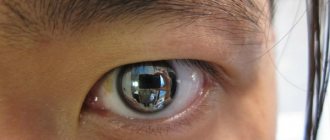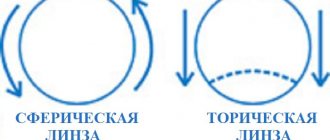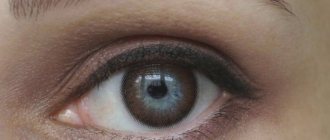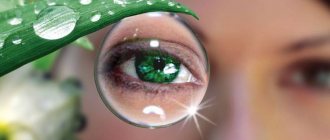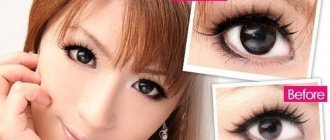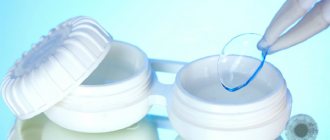How to understand how long the lenses are valid?
As a rule, each manufacturer first indicates on the packaging the year until which contact lenses can be worn, and then the month.
So, for example, if the package says 2022/09, this means that contact lenses can be used until September 2022. It is worth considering that the shelf life indicated on the package is maximum only if the optical products are stored in a buffer solution located inside the blister. We draw your attention to the fact that it does not matter what day you purchased contact correction products. Even if the lenses in their packaging expire the day after purchase, these optical products can still be worn. The fact is that after the specified time, the solution itself may deteriorate, but not the ophthalmic products. Much more important is the fact in which solution the lens is located. If it is expired, then it loses its disinfecting properties, which means that optical products begin to dry out and gradually lose their inherent properties.
The second concept that every user who chooses to wear lenses should know is the service life of optical products. During this time they can be used. It begins on the day you first put them on your eyes, and is in no way related to the period indicated on the closed package. The period of time during which correction products can be worn is indicated on the blister itself.
It is important to know
Shelf life is an indicator that guarantees the safety of optical products in closed packaging. When wearing contact lenses, you need to focus on the service life (SE). It includes the replacement period and wearing mode of contact lenses.
SE means the time during which the product is suitable for use after opening and performs its declared functions without causing harm to health. For example, the occurrence of allergic reactions, blurred vision, additional discomfort, itching, swelling of the cornea. It is indicated on the lid of the blister or cardboard box, and is also duplicated on the insert - instructions for use.
The service life depends on the material used for manufacturing, the type of optics, and the declared wearing mode. SE is shorter for colored CLs used to correct eye color, giving them a different shade. A longer period is typical for lenses with diopters. It can be 3, 6, 12 months or more.
It is important to consider the period of wearing the optics: daily replacement, continuous, prolonged use. Approximately 2 times the quality and possible period of use are affected by compliance with storage rules, proper cleansing of microorganisms, bacteria, protein and lipid deposits. When sleeping in the product, SE decreases.
What determines the shelf life of lenses?
What factors influence the shelf life of colored lenses, tint lenses and, of course, optical ones. Modern manufacturers highlight the following characteristics inherent in any lenses:
- thickness;
- moisture level;
- polymer quality;
- preparation method.
It is believed that the smaller the thickness of the material used in the production of optical products, and the higher their hydrophilicity, the shorter their service life.
How to care for colored lenses
Proper care of colored lenses requires knowledge not only of their type. Pay attention to the information about what mode to wear them in and when to change them. You will need a standard set of tools: a special solution for cleaning and disinfection and a sterile container.
For planned replacement models, systematic processing is essential. Bausch&Lomb universal multifunctional solutions for disinfection, cleansing and moisturizing, such as Biotrue® (instructions), ReNu MultiPlus® (instructions), ReNu® MPS (instructions), are ideal for cleaning colored contact lenses.
Can the expiration date expire earlier?
It often happens that the period indicated on the packaging of contact lenses ends earlier. Why does this happen? If you regularly use optical products, you must strictly follow the operating instructions. If you handle them carelessly, this can lead to them losing their original appearance much earlier. In addition, it is necessary to ensure that various deposits, for example, protein or lipid, do not accumulate on their surface. Representatives of the fairer sex often encounter this problem when residues of decorative cosmetics begin to accumulate on the surface of the lenses. All this can have a very negative impact on the condition of the correction means and shorten their service life. That is why ophthalmologists strongly recommend cleaning them in a timely manner using a special solution. At the moment, there is a wide selection of products intended for the care and disinfection of optical products, including:
- universal;
- multifunctional;
- enzymatic;
- peroxide.
These solutions can be purchased at opticians and specialized online stores. We strongly recommend that you purchase a cleaning product and use it regularly. This will help you extend the life of ophthalmic products.
Types of contact lenses
You can use hard contact lenses for the entire month without removing them. The material for them is silicone, which allows oxygen to pass through to the eyes.
| Name | Material | Advantages | Flaws |
| Traditional (service life from 6 to 9 months) | Hydrogel materials | This is the cheapest material. These products can be cleaned using a solution or using enzyme cleaning tablets | As lenses age, various deposits can form on the material. |
| Frequent scheduled replacement (service life 1-2 weeks) | Materials that have a high moisture content | Complete absence of various complications in the absence of high-quality cleaning | No significant |
| Scheduled replacement (1 month) | Hydrogel and silicone hydrogel materials | Cleaning is easy and can be done using a multi-purpose solution | No significant |
| Quarterly replacement (service life 3 months) | Hydrogel materials | Less attention needs to be paid to cleaning, since the shelf life is short. | Same as traditional ones |
| Daily replacement (1 day) | Materials with high moisture content | No need for treatment with solutions | High price |
Many people prefer lenses for scheduled or daily replacement. Many people began to abandon traditional lens models, and therefore many manufacturers stopped producing them.
Hard
Modern hard contact lenses are made from silicone-based materials. Thanks to this, the lenses allow oxygen to pass through well and at the same time do not accumulate various deposits on their surface. In addition, hard lenses can be used for quite a long time.
Rigid contact lenses are recommended for people with astigmatism and teenagers with progressive myopia.
Such lenses require regular careful care and disinfection. This is necessary in order to avoid complications from their use.
It should be remembered that, unlike soft contact lenses, which take very little time to get used to, hard lenses require more time to adapt.
Advantages of hard contact lenses:
- When making them, the individual parameters of a particular person (visual acuity, size and curvature of the cornea) are taken into account.
- Proper care of lenses can extend their lifespan to several years, but only if vision does not deteriorate.
- The quality of vision correction with the help of such lenses is an order of magnitude higher than what soft lenses can provide. Rigid lenses do not deform due to the natural irregularities of the cornea, which provides a smooth surface and creates a unified optical system. Therefore, they are very suitable for astigmatism.
- They contain no water, which means the lenses do not dry out and do not draw water out of the eyes. There is no need to worry about developing dry eye syndrome.
- The lenses allow enough oxygen to pass through, so the eyes do not experience hypoxia.
- Slow formation of deposits on the surface of hard lenses.
Disadvantages of hard contact lenses:
- Adaptation is required to get used to the lenses. It should be noted that if you stop wearing lenses for a few days, it will take time to adapt again.
- The diameter of hard lenses is quite small, so they can move or fall out of the eyes due to sudden shocks or friction.
- Dust and other small particles can get under the lenses and irritate the cornea.
Soft
Soft contact lenses contain up to eighty percent water, so they have a flexible structure and allow oxygen to pass through well.
Modern materials from which such lenses are made are silicone hydrogel and hydrogel. The hydrogel absorbs water well, so they remain soft and flexible for a long time. And silicone hydrogel has very good oxygen permeability and hydration.
Soft lenses can be used to correct nearsightedness, farsightedness, astigmatism and presbyopia. But you should remember that such lenses are not suitable for everyone.
Lenses should not be worn by people who have diabetes, tuberculosis, glaucoma and sinusitis. And also for people who work in dusty areas, with chemicals, who are allergic to lens material, and who suffer from eye infections.
In case of vision correction for astigmatism, soft toric lenses are used. They have a special spherocylindrical shape, which compensates for the difference in the optical power of the meridians, and vision becomes clear.
Benefits of soft contact lenses:
- The lenses are comfortable to use, there is no adaptation period.
- If extended-release lenses are used, their period of use increases to thirty days.
- The schedule for replacing soft lenses can vary greatly (every day, every few weeks, every month, etc.).
Disadvantages of soft contact lenses:
- Vision fluctuations with astigmatism.
- Lenses absorb a variety of contaminants (smoke, cream, etc.).
- In dry air, lenses can dry out before the eyes, and this leads to a change in their optical power and the development of “dry eye” syndrome.
- Dry lenses may develop cracks. These lenses can no longer be worn.
Day
Day lenses are meant to be worn during the day only. They must be removed before going to bed.
Daytime wearing of lenses is limited in time and is no more than twelve hours a day. After use, they must be disinfected and placed in a container with a storage solution.
Daytime contact lenses are suitable for almost any vision problem. It could be:
- Myopia (nearsightedness).
- Hypermetropia (farsightedness).
- Astigmatism (change in the shape of the cornea or lens).
- Age-related changes in vision.
Daytime lenses are comfortable and provide good vision thanks to a high degree of oxygen permeability and a material that protects the eyes from drying out.
Night
Night wear lenses are also called orthokeratology lenses. These are special lenses that are worn only at night. While a person sleeps, the corneal epithelium is rebuilt, resulting in a temporary improvement in visual acuity, and one can walk throughout the day without glasses or contacts.
The lower the degree of myopia, the longer the effect of night lenses lasts.
Nighttime contact lenses are safe to use and do not adversely affect the cornea. It should be remembered that when you stop using such lenses, the effect is reduced to zero.
The use of such lenses can cause unpleasant complications, such as corneal edema, astigmatism and decentration.
Night wear lenses can be used for a period of one to one and a half years.
Extended (from a month or more)
Extended wear lenses can be used for a whole month. Thanks to this mode, the lenses are perfect for people who lead an active lifestyle and play sports, work at night, or for those who find it difficult to adhere to a wearing regimen.
To avoid dryness and irritation when using extended wear lenses, they need to have certain parameters.
Such lenses transmit oxygen very well through their surface, so the cornea of the eyes constantly “breathes”. In addition, the eyes are well hydrated due to the high water content in the extended wear lenses.
Extended wear lenses cannot be used if astigmatism is greater than 1.0 diopter. According to statistics, extended wear lenses cause various complications much more often than other types of lenses. So, blepharitis, decentration, photophobia, infectious infection, corneal edema, and so on may develop.
Flexible
According to ophthalmologists, a flexible mode of wearing contact lenses is the most optimal. A person takes off their lenses before going to bed and puts them back on during the day. But sometimes you don’t have to take your lenses off at night, but sleep right in them. There will be no harm from this.
This will only be safe if the lenses are made of silicone hydrogel or are rigid and gas permeable.
There are many types of contact lenses. The length of time you wear them depends on what lenses you use.
Based on the time of continuous wear, contact lenses can be divided into three groups:
- Contact lenses for daily wear. Such lenses must be removed at night. The maximum continuous wearing time is 14 hours.
- Long-term wear contact lenses. This type of contact lens can be left on for a week.
- Continuous wear contact lenses. They are allowed not to be removed for one month.
Despite the fact that manufacturers allow the continuous wearing of some types of contact lenses, it is better not to abuse this and do not be lazy to remove the lenses before going to bed.
Will the wearing period increase if the lenses are used irregularly?
Some users believe that if they do not wear correction products every day, this will help extend the period of use. However, ophthalmologists strongly do not recommend doing this. Considering that the main factors influencing the reduction of service life directly depend on the users themselves, their compliance with the rules of putting on and taking off and the regularity of treatment with the solution, it is quite possible to increase the period of use. For example, you can wear optical products not every day, as recommended by the manufacturer, but every other day, periodically replacing them with glasses. However, according to ophthalmologists, this wearing regimen can have a very negative impact on the organs of vision, and therefore it is better not to abuse it and follow the manufacturer’s recommendations.
Flexible lens wearing mode
The improved properties of contact lens materials still do not provide a 100% guarantee that complications that are possible with continuous lens wear will not occur. According to the unanimous conclusion of the overwhelming majority of experts, the ideal option for wearing them is a flexible mode, when the lenses are removed at night, but if necessary, it is possible to sleep in them without fear for the condition of the eyes. This option is especially suitable if you use rigid gas permeable or soft silicone hydrogel lenses.
In the medical department, everyone can undergo examination using the most modern diagnostic equipment, and based on the results, receive advice from a highly qualified specialist. We are open seven days a week and work daily from 9 a.m. to 9 p.m. Our specialists will help identify the cause of vision loss and provide competent treatment for identified pathologies. Experienced refractive surgeons, detailed diagnostics and examination, as well as the extensive professional experience of our specialists allow us to ensure the most favorable result for the patient.
The cost of selecting contact lenses in our clinic is 1,500 rubles. Prices for other medical services at MGK can be found here.
can find out the cost of a particular procedure or make an appointment at the Moscow Eye Clinic by calling multi-channel phone 8 (daily from 9:00 to 21:00, free for mobile phones and regions of the Russian Federation) or using the online registration form.
How long can lenses be used?
The period of time over which optical products can be used is often clear from their name.
- One-day - can only be used for one day. After this time they must be thrown away;
- Two-week - used for 14 days;
- Menstruation - can be worn for 30 days;
- Quarterly - used for 3 months;
- Traditional - can be worn for six to nine months.
Remember that the period of use of optical products should be chosen only by an ophthalmologist, based on the results of the examination. In addition, you should not exceed the wearing period indicated by the manufacturer on the lens packaging.
How does opening lens packaging affect SG?
There are two types of CL packaging: cardboard boxes and blisters, where the cells directly contain optical products.
When the cardboard box is opened, the SG does not change if the storage rules are followed.
When opening a blister containing contact lenses, the sterility and tightness are compromised. In this case, attention is paid not to the expiration date, but to another parameter - the service life. Blisters with products must be stored in the original box. It additionally protects against exposure to sunlight.
After opening the secondary packaging or blister, the lenses must be placed in a special storage container and liquid. Before this, they are washed with an ophthalmic solution, which, according to the instructions, is changed over a certain period. When wearing contact lenses, it is important to clean, disinfect, and remove deposits of proteins and fats, waste products of microorganisms, fungi and bacteria.
If the blister with optics is opened but not used, the service period still runs.

